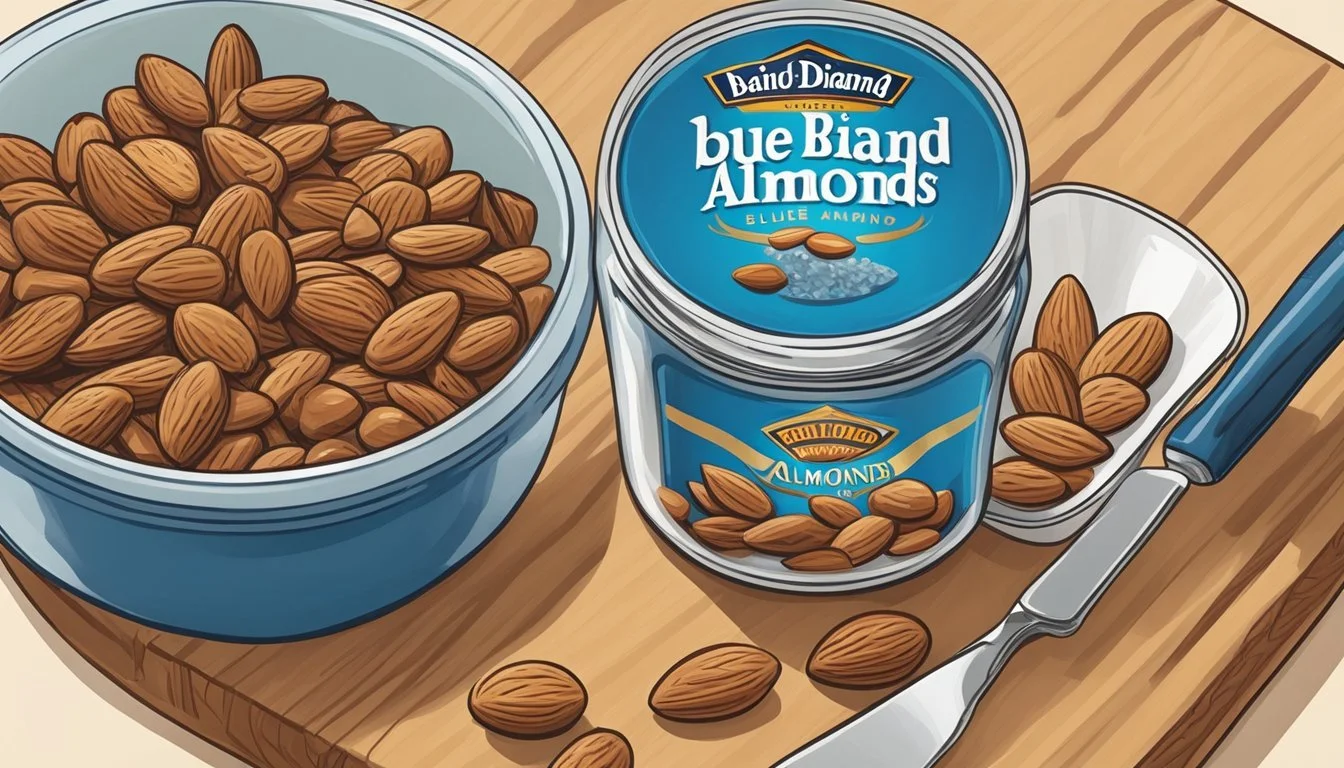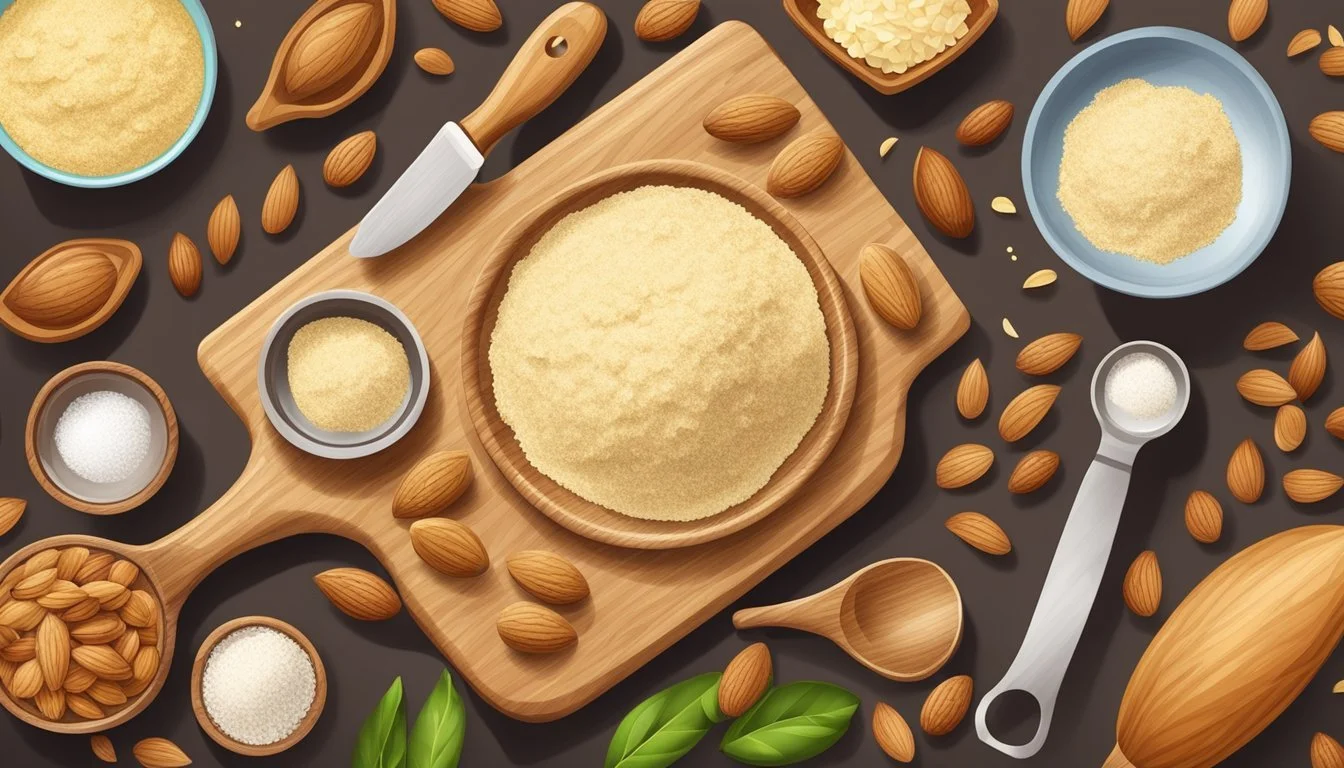How to Cook with Blue Diamond Almonds
Elevating Snacks and Garnishes with Ease
Cooking with almonds, specifically Blue Diamond almonds, offers a spectrum of culinary possibilities, from enhancing the texture of a dish to adding a wholesome, nutty flavor. Almonds are renowned for their health benefits, including being a source of protein, fiber, and healthy fats, making them an excellent choice for snacking. Incorporating these nuts into dishes not only boosts the nutritional profile but also provides a satisfying crunch.
Blue Diamond, a brand recognized for its variety of almond products, presents numerous options for those looking to get creative in the kitchen. The versatility of almonds is evident with their ability to complement both sweet and savory recipes. They can be transformed into a fine flour for baking, sliced for garnishes, or used whole in energy bites and granolas.
For snacking, the convenience of almonds cannot be overstated. They offer a portable, nutrient-rich snack that fits into a variety of dietary preferences, including plant-based, keto, and gluten-free lifestyles. As a garnish, lightly toasted almonds add an appealing texture and a hint of luxury to dishes, elevating them with minimal effort. Cooking with Blue Diamond almonds provides an opportunity to explore a world of flavor while keeping health in the forefront.
Choosing the Right Almonds
When selecting almonds for snacks and garnishes, it's important to consider both the type and nutritional value. Blue Diamond offers a variety of almonds that can cater to different cooking needs and health preferences.
Types of Blue Diamond Almonds
Blue Diamond Almonds come in several forms, suitable for both snacking and cooking applications. Here is a brief overview:
Whole Natural: Ideal for snacking or as a garnish on salads and other dishes.
Roasted: Available in both salted and unsalted options, roasted almonds add a crunchy texture and rich flavor to dishes.
Sliced and Slivered: Perfect for baking or as toppings, they add a delicate almond taste without overpowering other ingredients.
Almond Flour: It's a gluten-free flour alternative that provides a mild almond flavor and is used in various baking recipes for added richness.
Nutritional Benefits
Almonds are not only versatile in cooking but also offer substantial nutritional benefits:
Protein: A key macronutrient for muscle repair and growth. One ounce of Blue Diamond Almonds contains around 6 grams of protein.
Healthy Fats: Rich in monounsaturated fats that can contribute to heart health.
Calories: An energy-dense snack, with approximately 160 calories per ounce, making them a filling option.
Vitamins and Minerals: A source of vitamin E, magnesium, and calcium, among other nutrients.
When using Blue Diamond Almonds, one can expect not only taste but also health benefits, including contributions to a balanced diet with their protein and healthy fat content.
Prepping Almonds for Cooking
Before cooking with Blue Diamond almonds, one must properly prepare the almonds to ensure they unleash their full flavor potential. Whether using them as a stand-alone snack or as a crunchy addition to a dish, proper preparation enhances their texture and taste.
Roasting Techniques
To roast almonds, one should preheat the oven to 350 degrees Fahrenheit. Then, in a bowl, mix the almonds with a small amount of olive oil until they're lightly coated. This helps the seasoning stick and gives them a delicious crispness. Lay the almonds out in a single layer on a baking sheet, making sure they're spaced evenly for consistent roasting. Sprinkle with kosher salt or other desired seasonings. Roast for 15-20 minutes, flipping them halfway through to ensure they're evenly toasted.
Slicing and Dicing
When adding almonds to recipes as garnishes, freshly slicing or dicing allows for the freshest flavor and crunch. Using a sharp knife and a stable cutting board, one can slice almonds thinly for a delicate addition to salads or chop them into bigger pieces for a heartier bite in baked goods and other dishes. It's crucial to use a gentle sawing motion if slicing, or a firm, downward motion if dicing, to prevent the almonds from shooting off the board.
Simple Almond Snack Recipes
Blue Diamond Almonds lend themselves to a range of delectable snack recipes that are both easy to prepare and delicious. These snacks can be sweet or savory, suitable for any taste preference.
Sweet Almond Treats
Chocolate Almond Dipped Pretzels
One can quickly dip pretzels in melted dark chocolate and roll them in crushed almonds for a satisfying sweet and salty snack.Honey Roasted Almonds
To prepare, simply coat almonds in a mixture of honey and coconut oil, then roast in the oven until they're golden and fragrant.
Recipe Table for Honey Roasted Almonds
Ingredient Quantity Preparation Almonds 1 cup Honey 2 tablespoons Runny preferred Coconut oil 1 tablespoon Melted Sea salt To taste
Instructions:
Preheat oven to 350°F (180°C).
Mix almonds with honey and coconut oil, ensuring each almond is coated.
Spread on a baking sheet lined with parchment paper.
Sprinkle with sea salt.
Roast in the oven for about 10-15 minutes, stirring occasionally.
Savory Almond Snacks
Roasted Salted Almonds
Simply toss almonds in melted butter and sea salt, then bake until toasty for a classic savory snack.Spicy Smokehouse Almonds
Almonds coated with a blend of olive oil, spices, and a dash of hot sauce deliver a kick that is ideal for spice enthusiasts.
Recipe Highlights for Spicy Smokehouse Almonds
Ingredient Quantity Description Almonds 1 cup Preferably Blue Diamond Almonds Olive oil 1 tablespoon For coating Seasoning mix As needed Including preferred spices Hot sauce A few drops Adjust to desired spiciness
Instructions:
Preheat oven to 350°F (180°C).
In a bowl, mix oil, seasonings, and hot sauce.
Add almonds, toss to coat evenly.
Spread almonds on a greased baking pan.
Bake for 15-20 minutes, stirring twice during cooking.
Almond Garnishes for Dishes
Blue Diamond almonds can elevate the visual appeal and taste of various dishes. When used as garnishes, they add a pleasant texture and nutty flavor that can complement both sweet and savory recipes.
Salads and Toppings
When enhancing salads, the addition of almonds can transform an ordinary dish into a crunchy and satisfying meal. They can particularly uplift the texture of summer salads:
Baby Spinach Salad: Toast Blue Diamond almonds and sprinkle over baby spinach leaves for added crunch.
Fruit Salad: Garnish with slivered almonds for a contrasting texture to the juicy fruit pieces.
Entrees Enhancement
To add depth to entrees, almonds serve not only as a garnish but also contribute to the dish’s flavor profile:
Cheese-Crusted Chicken: Crush almonds and mix with grated cheese to create a crust for chicken breasts.
Parsley-Almond Topping: Finely chop parsley with toasted almonds and use as a finishing touch to pasta dishes.
Healthy Snack Alternatives
Opting for healthier snacks can be a straightforward way to improve one's dietary habits. Blue Diamond Almonds can be an integral part of this by serving as a satisfying and nutritious ingredient in snack alternatives.
Nut-Based Bars and Bits
Nut-based snack bars are a convenient and healthy option for those on the go. By using Blue Diamond Almonds, individuals can create homemade, nutrient-dense bars that are rich in protein and healthy fats. Here is a simple recipe idea featuring almonds:
Ingredients:
1 cup Blue Diamond Almonds, roughly chopped
½ cup oats
¼ cup almond butter
¼ cup maple syrup or honey
Optional: dried cranberries or dark chocolate chips
Instructions:
Mix the almonds, oats, and any optional ingredients in a bowl.
Warm the almond butter and syrup until easily combined, then mix with the dry ingredients.
Press the mixture firmly into a lined baking dish and chill until set.
Cut into bars or bite-sized bits.
These homemade bars are free from added preservatives and can be customized with the addition of coconut flakes, banana chips, or other preferred ingredients, ensuring control over the nutritional content.
Vegetable Pairings
Pairing Blue Diamond Almonds with fresh vegetables can create a satisfying snack that's both tasty and beneficial. Almonds can be used as a crunchy topping on salads or as an addition to veggie platters, giving a boost of flavor and texture. Examples of optimal vegetable pairings include:
Thinly slice veggies like cucumbers, carrots, and bell peppers.
Toss with a handful of chopped Blue Diamond Almonds.
Dress with a vinaigrette or lemon juice for added zest.
Stuffed Mini Peppers:
Mix cream cheese with finely ground Blue Diamond Almonds and herbs.
Stuff the mixture into halved mini bell peppers.
Serve chilled for a refreshing and protein-rich treat.
These nutritious combinations leverage the natural flavors of almonds and vegetables, delivering a snack that satisfies the palate while contributing to daily nutrient intake.
Cooking With Almond Flour
Almond flour, made from finely ground almonds, provides a gluten-free alternative to traditional flour, enriching recipes with its nutty flavor and nutritious profile. It's especially useful for making delightful almond shortbread cookies and various gluten-free baked goods with textural nuance and taste depth.
Almond Shortbread Cookies
Making Almond Shortbread Cookies with Blue Diamond Almond Flour begins by combining the almond flour with softened butter and brown sugar to create a tender base.
Preheat the oven to 350°F (175°C).
Cream together:
1 cup unsalted butter, softened
2/3 cup brown sugar
Gradually mix in:
2 cups Blue Diamond Almond Flour
1/4 teaspoon salt (optional)
Press the dough into an ungreased baking pan or shape into discs on a baking sheet.
Bake for 8-10 minutes, or until edges turn a light golden brown.
Let the cookies cool before serving to achieve the classic shortbread texture.
Note: Almond flour's fat content may cause quicker browning; watching the cookies closely as they bake is recommended.
Gluten-Free Baking
Blue Diamond Almond Flour shines in Gluten-Free Baking, offering a satisfying texture without gluten's effects for those with sensitivities or preferences.
Substitution: Typically, one can replace wheat flour with almond flour in a 1:1 ratio, but adjustments to the recipe might be needed due to differences in moisture absorption.
Binding Agent: Since gluten-free recipes lack gluten's binding properties, adding xanthan gum or eggs is important for structure and texture.
Example: For a simple gluten-free pancake mix:
Combine the following in a bowl:
1 cup Blue Diamond Almond Flour
1 tablespoon sugar
1/4 teaspoon salt
1/4 teaspoon baking soda
In another bowl, whisk together:
3 eggs
1/4 cup water or almond milk
1 tablespoon oil
Merge the wet and dry ingredients and let the batter rest for a few minutes.
Cook on a preheated, greased griddle, flipping pancakes once bubbles form on the surface.
Tip: Gluten-free baked goods might be more delicate, so they must be handled gently while still warm.
Specialty Flavored Almonds
Almonds can be transformed into a myriad of specialty flavors through the addition of seasonings and spices, introducing an exciting twist to snacks and garnishes. The versatility of almonds makes them a prime candidate for creating snack options like smokehouse almonds or garnishes infused with exotic spices like wasabi.
Incorporating Seasonings
To create Smokehouse Almonds, one can mix almonds with a combination of garlic powder, cayenne pepper, and smoke flavoring. This robust blend provides a deep, smoky taste with a hint of heat. For those who favor a punch of heat, Sriracha-flavored almonds are another popular option. They are typically coated with a mixture of sriracha sauce and additional spices before being roasted to perfection, achieving a balance of tang and spice.
Herb and Spice Infusions
Exploring the realm of herb and spice infusions offers a spectrum of flavors. Wasabi and Soy Sauce Almonds are a prime example of how a bold, piquant taste can be infused into almonds. They are often tossed with a wasabi seasoning blend and a light splash of soy sauce before drying or roasting. Similarly, for a zesty kick, one might consider Habanero BBQ almonds, which combine the smokiness of barbecue with the fiery taste of habanero chilli, achieved by integrating habanero powder into the BBQ coating. Another infusion involves brushing the almonds with a garlic-infused oil, then lightly dusting them with fine garlic powder, fostering a milder, savory profile perfect for use as a garnish on salads or entrees.
Creating Almond Butter at Home
Creating almond butter at home is a straightforward process that can yield a fresh, wholesome snack or garnish. It requires a minimal set of ingredients with almonds as the primary focus, and a kitchen appliance to blend them into a creamy spread.
Blending Techniques
The essential tool for making almond butter is either a food processor or a high-speed blender. For a standard batch, one should begin with toasting the almonds to enhance their natural flavors. A preheated oven at 350°F (175°C) is ideal for roasting the almonds for approximately 10 minutes, or until they're a golden hue and aromatic, ensuring to stir them halfway for an even roast. After the almonds have cooled slightly and are still warm to the touch, they are ready to be blended.
To achieve a creamy texture, one must process the toasted almonds on a high setting, pausing intermittently to scrape down the sides. The almonds will progress from a grainy texture to a clump, and with persistence, they will ultimately transform into smooth almond butter.
Tip: Apply constant pressure with a tamper if using a Vitamix or similar blender to encourage an even blend.
Flavor Variations
Homemade almond butter can be diversified with an array of flavors for added dimension and personal taste.
For a sweet twist: Swirl in a tablespoon of honey or maple syrup once the almond butter has reached its desired consistency.
For chocolate enthusiasts: Add a handful of chocolate chips during the final minutes of blending for a decadent touch.
For additional flavor: Experiment by including a pinch of salt or a dash of cinnamon to cater to individual palates.
Creating almond butter at home allows for control over the ingredients and flavors, resulting in a nutritious and customizable addition to snacks and garnishes.
Almond Pairings for Cheese Boards
When crafting a cheese board, the inclusion of almonds adds a satisfying crunch and flavor contrast that complements a wide array of cheeses and fruits. With thoughtful pairings, Blue Diamond Almonds can elevate the tasting experience.
Fruit and Nut Combinations
To create harmonious fruit and nut combinations, one should consider the texture and flavor profiles that either contrast or complement each other. Here are some expert pairings:
Bold Cheeses and Tart Fruits: Pair Blue Diamond Smokehouse Almonds with strong cheeses like aged cheddar or gouda, and add a splash of color with tart pomegranate seeds or cherries for a balance of flavors.
Soft Cheeses and Sweet Fruits: Combine creamy goat cheese with Blue Diamond Honey Roasted Almonds, and include slices of figs or apples to bring out the natural sweetness of the nuts.
Selecting Cheeses and Meats
The right selection of cheeses and cured meats (What wine goes well with cured meats?) can serve as the backbone of any cheese board, providing a range of textures and tastes. Incorporating Blue Diamond Almonds offers an extra layer of sophistication. Here are curated selections:
Cheese:
Soft: Brie or Camembert pair well with the subtle, nutty taste of Blue Diamond Natural Almonds.
Semi-hard: Manchego or Swiss cheese can handle a more robust almond like the Blue Diamond Wasabi & Soy Sauce variety.
Hard: Aged Parmesan or Pecorino, with their salty and sharp characteristics, go well with the straightforward flavor of Blue Diamond Roasted Salted Almonds.
Meats:
Cured Meats: Delicate prosciutto or spicy salami complements the creaminess of almonds, providing a fantastic mouthfeel and depth of flavor.
Extras: For variety, consider adding marinated olives to introduce a briny flavor that contrasts pleasantly with the richness of the almonds and creaminess of the cheeses.
Using Almonds in Main Courses
Almonds elevate main courses by adding a rich, nutty flavor and a satisfying crunch. In seafood dishes, they impart a subtle depth, while in vegetarian options, they serve as a hearty protein boost.
Seafood Enhancements
For seafood lovers, almonds provide a delightful contrast in texture and taste. Broiled Salmon with Almond Crust, for instance, showcases the fish's tenderness with the almonds' crispy layer. A recommended recipe could include a topping of crushed almonds mixed with herbs and a hint of lemon zest, broiled until golden. This can be served alongside a vibrant Spinach and Romesco Sauce, where ground almonds thicken the sauce and enhance its robustness.
Vegetarian Protein Options
Vegetarians can harness the protein content of almonds to supplement their diet. A dish like Quinoa Bowls with Almond Tofu pairs the complete protein of quinoa with tofu baked in a peanut and almond crust. For a sweet hint, the dish can be garnished with a sprinkle of Blueberries, adding a fresh burst that complements the almonds' crunchiness. This combination not only satisfies protein requirements but also adds a diverse range of textures and tastes to a vegetarian meal.
Beverage Pairings with Almonds
The right beverage can elevate the experience of snacking on Blue Diamond Almonds. Selecting the perfect drink to complement the rich and nutty flavors requires attention to the beverage's taste profile.
Wine Selection
White Wine: A crisp, dry white wine pairs beautifully with Blue Diamond Almonds. Look for wines with a clean acidity, such as a Sauvignon Blanc or Pinot Grigio, which cut through the richness of the nuts without overwhelming their flavor. For those enjoying herb-coated almonds, like those with rosemary, seek out a white wine with herbal notes to match.
Sea Salt Almonds: Match with Chablis or Sancerre for a harmonious balance.
Herb Almonds: Select a Sauvignon Blanc with grassy undertones.
Non-Alcoholic Alternatives
Flavored sparkling waters or herbal infusions make excellent non-alcoholic pairings for Blue Diamond Almonds. Consider a sparkling water with hints of citrus to provide a refreshing contrast to the savory snacks. (What wine goes well with savory snacks?) When opting for herbal infusions, ingredients such as celery, flat-leaf parsley, or other garden herbs can mirror the natural notes found in select almond varieties.
Sparkling Lemon Water: Combines well with roasted almonds for a zesty complement.
Herbal Tea with Parsley: Pairs with garden herb almonds, echoing the botanical flavors.
By paying attention to these beverage options, one can fully appreciate the flavor nuances of Blue Diamond Almonds as both a snack and garnish.
Storing Almonds for Freshness
Almonds, a versatile and nutritious ingredient for snacks and garnishes, retain their quality when stored correctly. Maintaining the freshness of almonds is paramount for both taste and health benefits. Proper storage methods extend almonds' shelf life, ensuring they remain a delicious addition to various dishes.
Temperature: Keep almonds in cool conditions, ideally between 32°F (0°C) and 50°F (10°C).
Moisture: Store in a dry area, away from moisture, to prevent spoilage.
Light: Almonds should be kept out of direct sunlight, which can accelerate the deterioration process.
Container Selection:
Airtight Containers: Utilize airtight containers to safeguard almonds from air exposure, which can lead to rancidity.
Sealable Bags: If airtight containers are unavailable, resealable freezer bags may also be used. These should have excess air pressed out before sealing.
Almonds can be stored longer when placed within the refrigerator or freezer, both of which create an ideal environment by maintaining consistent, low temperatures. For those using almonds frequently, keeping a small quantity at room temperature is acceptable, provided they are consumed within a couple of days.
Summary of Storage Tips:
Environment Container Type Usage Period Refrigerator/Freezer Airtight Containers/Sealable Bags Long-term storage Room Temperature Airtight Containers/Sealable Bags Immediate consumption (1-2 days)
In essence, ensuring that almonds are stored in airtight containers within a cool and dry environment will preserve their freshness and maximize their shelf life. This care in storage allows almonds to remain a go-to choice for adding that crunchy texture and nutty flavor to snacks and garnishes.
Finding Blue Diamond Products
When looking for Blue Diamond almond products to enhance snacks and garnishes, consumers can easily find them both in physical retail locations and through online shopping platforms. Many stores offer coupons and promotions for Blue Diamond almonds, contributing to a cost-effective shopping experience.
Retail Locations
Consumers can purchase Blue Diamond products at various supermarkets, health food stores, and club warehouse outlets across the country. They should look for the distinctive Blue Diamond logo in the snack aisle or where baking products are displayed. Checking the local store's flyer or website for coupons can often lead to savings on Blue Diamond almonds.
Examples of Retailers Known to Stock Blue Diamond Almonds:
Walmart
Target
Costco
Whole Foods Market
Safeway
Kroger
Online Shopping
For convenience, customers can also find Blue Diamond almonds on online marketplaces and grocery delivery services. They have the option to buy in bulk or in individual packages, providing flexibility based on their needs. Online coupons could be available through discount codes or during special sale events.
Popular Online Platforms to Purchase Blue Diamond Products:
Amazon
Blue Diamond’s official website
Instacart
Jet.com
Walmart Grocery
Making Almond Milk
One can effortlessly make almond milk at home with simple ingredients like almonds, water, and a pinch of salt. For those who prefer a touch of sweetness, sweeteners, such as honey or maple syrup, can be added.
To start, one needs to soak the almonds in water overnight. This softens the almonds, making them easier to blend and helping to unlock their nutrients. Typically, one cup of almonds requires two cups of water for soaking.
Ingredients:
1 cup almonds
2 cups water (for soaking)
3-4 cups water (for blending)
Pinch of salt
Sweetener (optional)
Instructions:
Drain and rinse the soaked almonds.
Place almonds into a blender with 3-4 cups of water and a pinch of salt.
For sweetness: Add sweetener to taste at this point.
Blend on high speed for 1-2 minutes until the mixture is creamy.
Strain the blend using a nut milk bag or a fine mesh sieve lined with cheesecloth.
The result is fresh, homemade almond milk. It can be enjoyed as a drink, added to cereal, or used in recipes as a dairy milk substitute.
Additional flavors, such as vanilla or chocolate, can be incorporated post-blending for a flavored milk variant. The leftover almond pulp can be dried and used in baking or as a grain-free flour alternative.
One should store the almond milk in a sealed container in the refrigerator. Homemade almond milk typically remains fresh for a few days.
Almond Use in Different Cuisines
Almonds offer a versatile texture and flavor that enhances a variety of dishes across multiple cuisines.
Asian-Inspired Dishes
Asian cuisine often incorporates almonds as a key ingredient to add crunch and nutrition to dishes. A classic example is in Asian Quinoa Bowls, where almonds are paired with peanut baked tofu. The dish may include a savory sauce made with soy sauce, enhancing the natural nuttiness of almonds. They often contrast well with sweeter components, balancing the overall flavor profile.
Key flavors: soy sauce, peanut, sweet nuances
Combination: Almonds + soy sauce + tofu
Mediterranean Flavors
In Mediterranean cooking, almonds are a staple, often found in both savory and sweet preparations. Almonds sautéed with shallots and garlic, then finished with a spritz of lemon, turn simple green beans into an elegant side dish. Additionally, almonds are frequently used in conjunction with olive oil to create rich, deeply flavored sauces or to simply garnish salads for added texture.
Key ingredients: shallots, olive oil, garlic, lemon
Usage: Garnish for greens, base for sauces
Usage Dish Example Almond Form Accompanying Ingredients Garnish Green beans with almonds Toasted Shallots, garlic, lemon Sauce Base Almond-olive oil sauce Ground Olive oil, spices
Sustainable Practices of Almond Farming
Almond farming in California has embraced a series of sustainable practices to address environmental concerns, particularly those related to water use and carbon footprint. As drought conditions persist, almond farmers are increasingly committed to conserving water and promoting soil health.
Water Efficiency:
Farmers utilize micro-irrigation systems which deliver water directly to the roots of the trees, dramatically reducing wastage.
They have successfully reduced the water needed to grow a pound of almonds by 33 percent, showcasing significant improvements in efficiency.
Soil Health and Carbon Sequestration:
Almond trees provide a no-till environment that preserves soil structure and health over their 20-25 year lifespan.
At the end of their life cycle, almond trees can be ground and incorporated back into the soil, a method known as Whole Orchard Recycling. This extends carbon sequestration by storing carbon in the soil.
Almond Byproducts:
Shell and hull byproducts are utilized rather than discarded, contributing to a more circular economy. Shells can become livestock bedding, while hulls serve as cattle feed.
Almond farmers align with various sustainability programs such as the California Almond Sustainability Program (CASP), which aggregates and showcases collective efforts to improve sustainability. Through initiatives like these, the almond industry aims to communicate its commitment to sustainable agriculture and minimize its environmental impact.














